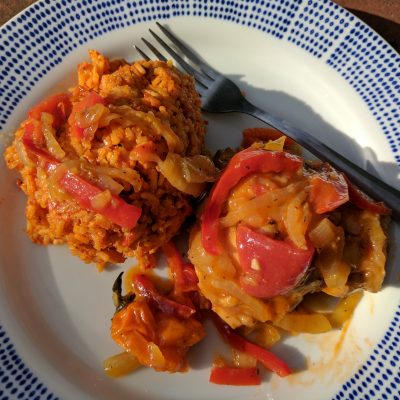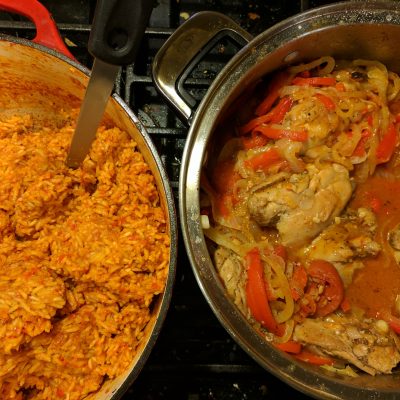


All jollof starts with the same essentials: rice, tomatoes, onions and chili peppers. But from there it varies greatly from country to country and chef to chef.
What do you know, another celebration dish! I seem to be drawn to them. A steaming pot of jollof rice is the mainstay at birthday parties, naming ceremonies, weddings, funerals and pretty much any family get together across West Africa. But while it’s the source of much joy, it’s also the source of spirited debate: where did jollof originate, and how should it be made?Senegalese, Gambians, Nigerians, Sierra Leoneans, Liberians and Ghanaians all claim this dish to be their own; even among natives of the same country, every jollof aficionado claims to have the “true recipe.” The friendly quarrel is even the topic of rap songs (“Ghana jollof, Ghana jollof, Ghana jollof – yummy! Nigerian jollof is tastes funny”), “Rice-Off” competitions, and has it’s own hash tags (#jollofwars, #jollofgate)! The authors of my cookbook also describe this dish as the most contest dish they’ve created, because all of the authors had their own idea of how it should be made.
All jollof starts with the same essentials: rice, tomatoes, onions and chili peppers. But from there the differences abound: the type of peppers, the choice of oil, what type of meat or fish to use, the type of rice and whether the rice is cooked separately from the sauce or as a one pot affair are just a few of the ways this dish varies from country to country. This recipe is probably a blend of multiple influences, but most closely represents the Nigerian variety: the onions, peppers and tomatoes are blended and cooked down and used to steam the rice – which is parboiled separately from the jollof sauce.
Courtney and I loved this recipe, and he pointed out that it reminded him a lot of paella – another rice dish where you have a few basic requirements but then many regional differences across Spain. It seems this sort of debate makes for a healthy competition and a dish that seems to just get better and better!. I can only speak to the jollof I made, but if anyone ever needs a “rice off” judge you know where to find me!
Recipe Source: Foods From Across Africa
|
1
Done
|
For the Rice |
|
2
Done
|
For the Rice |
|
3
Done
|
For the RiceAdd the tomato paste, cook for another minute or so, then remove from heat. In a blender or food processor, blend the mixture with 2 cups chicken broth. Return to the pan and add additional salt to taste. Heat the sauce until lightly bubbling and stir in the coconut butter to melt. |
|
4
Done
|
For the RiceAdd your rice to the pot. Stir gently so it's well coated with the red sauce, then reduce the heat as low as possible. Cover and simmer for 10 minutes. Stir, ensuring you scrape the center of the bottom of the pan so that the rice cooks evenly. Cover and simmer for another 10 minutes. Open and stir for a final time, then simmer for a final 10 minutes (30 minutes cooking time in total). Throughout this process, add more chicken broth if the rice runs out of liquid before softening. You may need to adjust the seasoning if you add a lot of liquid, as I did. Turn the heat off and allow to steam, covered, for another 15 minutes. Fluff with a fork. |
|
5
Done
|
For the Sauce/ChickenFinely slice the onions and bell peppers. Remove the skin from the chicken. In a large bowl, use your hands to toss the chicken with salt, pepper and thyme. |
|
6
Done
|
For the Sauce/Chicken |
|
7
Done
|
For the Sauce/ChickenAdd the remaining olive oil to the pan along with the onions and peppers; cook for 20 minutes, stirring occasionally. |
|
8
Done
|
For the Sauce/ChickenChop up the tomatoes. Add tomatoes, garlic and garlic paste into the pan; turn the heat to low and cook for 10 minutes. |
|
9
Done
|
For the Sauce/Chicken |
|
10
Done
|
To Serve |